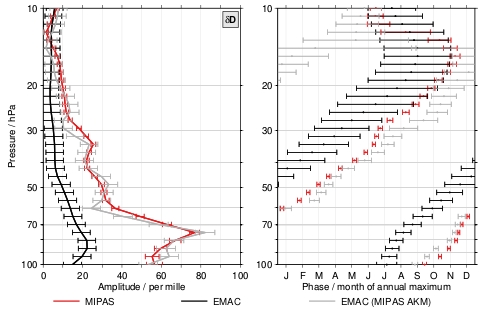Discrepancies of the amplitudes of the δD tape recorder between MIPAS and other data can be resolved by applying MIPAS averaging kernels

The figure shows the δD tape recorder in terms of amplitude (left) and phase (right), as measured by MIPAS (red), modelled by EMAC (black), and EMAC results with MIPAS averaging kernels applied (grey). The original large discrepancy in the amplitudes (black versus red) disappears almost completely (grey versus red) after application of the MIPAS averaging kernels. The phase of the taperecorder, expressed as the month of the seasonal maximum, agrees also better after application of the averaging kernels.
Steinwagner et al. (2010) detected a tropical tape recorder signal in the ratio between the main isotopologue H2O und the minor isotopologue HDO, which we call δD tape recorder in the following, and interpreted this as the result of moistening of the stratosphere by overshooting convection. Two years later, this finding was challenged by Randel et al. (2012) who found no tape recorder signal at all in the respective δD data set from ACE-FTS measurements. This discrepancy has now been resolved by a recent study by Lossow et al. (2019).
Lossow et al. found that the main discrepancy between ACE-FTS, EMAC model results, and MIPAS comes from a mismatch of the vertical resolution of HDO and H2O, both retrieved from MIPAS data. The two quantities should have had the same vertical resolution, but this was not the case. The different vertical resolutions created an artificial tape recorder-like signal. Another source of artefacts was the seasonal variation of the lowermost usable tangent altitude within the retrievals, determined by the top altitude of clouds making observations with lower lines of sight unusable for the data analysis. Finally, due to the global fit approach that allows upward error propagation, the seasonal variation of the lowermost usable tangent altitude impacted the retrieval in some layers above, up to about 25 km. All three effects can be taken properly into account by applying the MIPAS averaging kernels of HDO and H2O properly to the data set that is to be compared with. Here, we have demonstrated that discrepancies can be diminished when compared to the EMAC model result. Similar results are produced when comparing to the ACE-FTS data set in the correct way, or by correcting the MIPAS results for the artifically created signals. In the end, we find that, after correction for the unwanted effects, there remains no significant discrepancy between ACE-FTS, EMAC, and MIPAS. All three data sets confirm that there is a weak but significant tape recorder signal in delta-D in the tropics (maximum amplitude around 25 permille at about 85 hPa), which confirms that ice-lofting by overshooting convection plays a small but significant role in moistening the tropical stratosphere. Future versions of δD from MIPAS data will have the artefacts removed, by application of a different retrieval approach.
For more information see: https://doi.org/10.5194/amt-13-287-2020
